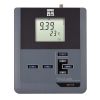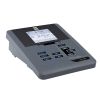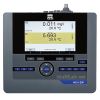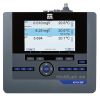YSI TruLab pH 1310 Benchtop Meter
Features
- Single channel measurement of pH, mV (ORP) and temperature
- Easy-to-read backlit display with text menu for easy operation
- Fast data transfer via USB in .csv or ASCII format or the optional integrated printer
- Free ground shipping
- Expedited repair and warranty service
- Lifetime technical support
- More
Overview
The YSI TruLab pH 1310 benchtop meter is the ideal laboratory instrument for reliable pH/mV measurements with automatic documentation for GLP compliance. The YSI TruLab pH 1310 is an accurate, easy-to-use solution for the measurement of pH or mv (ORP) in the laboratory. The YSI TruLab pH 1310 benchtop meter has internal memory and is available with or without a built-in printer. Stored data can be sent to a PC via USB or to an optional built-in printer available on the 1310P.
Reliable and Efficient
The TruLab pH 1310 benchtop meter's AutoRead function indicates when a stable measurement is reached, improving repeatability. Data can be printed directly from the instrument via the integrated printer or exported via USB.
Benefits
- Single channel measurement of pH, mV (ORP) and temperature.
- Easy-to-read backlit display with text menu for easy operation
- Fast data transfer via USB in .csv or ASCII format or the optional integrated printer
- Continuous Monitoring Control (CMC) function for monitoring the ideal measuring range for pH measurements based on the last calibration
- 1, 2, 3, 4 or 5 point calibration for pH
- 22 stored buffer sets for auto-buffer recognition and easy calibration
- BNC connection for pH, mV; 2 banana connections: 1 for an external temperature sensor and 1 for external reference if using a half cell
- 3-year warranty
- GLP/AQA compliant
- Wide selection of electrodes - pH, ORP and temperature probes
- (1) TruLab pH 1310 benchtop meter
- (1) Universal AC power supply
- (1) Electrode stand
- (1) USB cable
- (1) PC software
In The News
Scientists seek larger ocean acidification monitoring buoy network
The world’s oceans are becoming increasingly acidic, threatening not only countless marine organisms but also the livelihoods of millions of people in the fishing industry. Over 36,000 commercial fishing vessels operate out of the U.S. alone, many of which trawl the Pacific for salmon, herring and shellfish. The Pacific Marine Environmental Laboratory, a research branch of the National Oceanic and Atmospheric Administration, is hoping to expand their network of long-term monitoring buoys to better meet the challenges posed by ocean acidification. “While the ocean is always a challenging place for a buoy, the recession has been a recent challenge for the science community as well,” said Adrienne Sutton, a lead scientist in PMEL’s carbon group.
Read MorePrivate effort aims to wire Lake George into world's 'smartest lake'
As part of IBM’s Smarter Planet initiative, the company has poured millions into projects around the world to test out some of its new technologies and has gotten some good clippings in the press along the way. One well-known offshoot of this effort is Watson, the computer that famously beat human opponents at Jeopardy. But the initiative goes much farther than Watson, and some of the same engineers who worked on the supercomputer project have already turned their eyes to another one: the Jefferson Project, a joint effort between IBM, The FUND for Lake George and the Rensselaer Polytechnic Institute that is pushing the limits on lake monitoring.
Read MoreData buoy on Acadia National Park's Jordan Pond to help answer clarity questions
Acadia National Park, the oldest national park east of the Mississippi, sits off Maine's Atlantic coast and covers most of Mount Desert Island — an unlikely name for a landmass covered in lakes and ponds. One of those is Jordan Pond, the deepest on the island, which is a famously clear lake in a state famous for clear lakes. "Jordan Pond is historically one of the most transparent lakes in Maine--or at least that's what they claim," said Nora Theodore, a masters student in ecology and environmental science at the University of Maine. And though the lake remains incredibly clear, decades of monitoring show the clarity is trending downward. "It's an extremely low productivity system, but that's been changing," she said. Transparency in Jordan Pond has been in decline since the 1990s.
Read More



























